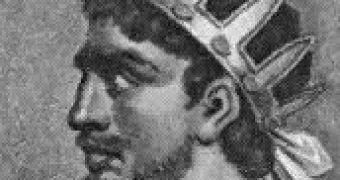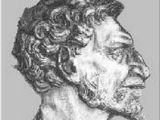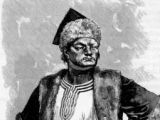Attila (403 -453) was the last and greatest king (or better said khan?) of the Huns. Attila means "Little Father" in Gothic or perhaps "Land-Father" in Hunnic. Atil was also the ancient name of the Volga River (renamed after Bulgarians, a Turkic people related to the Huns).
The historical context of Attila's life played a large part in determining his later public image: in the last years of the Western Empire, his conflicts with the general Aetius (called the "last of the Romans") and the strangeness of his culture and appearance contributed to cover him in the mask of the ferocious barbarian and enemy of civilization, as he has been portrayed in many films and other art forms.
Attila is known in Western history and tradition by the grim "Scourge of God", and his name has become a symbol for cruelty and barbarism. In the popular imagination, the steppe warlords such as the Mongol Ghengis Khan and Turkic Tamerlane were cruel, clever, and sanguinary lovers of battle and pillage.
The reality of his character may be more complex. The Huns of Attila's era had been mingling with Roman civilization for some time, largely through the Germanic tribes of the border. Priscus - a historian who traveled on an embassy of the Eastern Roman Empire to Attila in 448 AC - could identify Hunnic, Gothic and Latin as the three common languages in Attila's camp. He recounted his meeting with Romans fully assimilated into the Huns' way of life. The Roman historian describes Attila's humility and simplicity with admiration.
In the public culture, Attila is almost only showed as European. Often blond, long haired, with long blonde mustache and/or beard; straight Caucasoid face features, with huge, blue and blooded eyes. This is what we see in every painting, sculpture or movie depicting Attila. However, this doesn't fit the historical truth.
In many cases this is due to misconception or ignorance.
But it could also come from the wrong idea that the Huns are ancestors of the Hungarians. This way, Attila is thought to be Hungarian and consequently Caucasoid. Paradoxical in this concept is that Hungarians - at their arrival in Europe - were, in fact, of Mongoloid race (at most slightly mixed with Caucasoid populations) and their present racial type is the result of mixing and assimilation with neighboring European people.
The Huns vanished from history after Attila's death. There is a gap of almost five centuries between the Huns' disappearance from Panonia and the arrival of the Hungarians there.
Meanwhile, many populations installed in Panonia, the most notorious being the Avars (distantly related to the Huns).
Moreover, the Hungarians are not even related to the Huns; they speak an Ugro-Finnic language, so they are close to the Finns, Sami (Lapps), Estonians and even more to the Siberian tribes Mansi and Kanthy, which - by isolation - preserved the original Ugro-Finnic Mongoloid race. Less mixed Ugro-Finnic populations, like the Lapps, show obvious mixed features even today.
The only extant description on Attila's appearance is that of Priscus: "short of stature, with a broad chest and a large head; his eyes were small, his beard thin and sprinkled with gray; and he had a flat nose and a swarthy complexion, showing the evidences of his origin" (like this old illustration shows).
Attila's physical appearance was most likely that of an Eastern Asian, Mongol or Turkic. Europeans were not used to seeing these facial features and so they often described him in harsh terms.
Actually, what were the Huns? Historians think they are an early branch of Turkic speaking people who - in 2nd century - departed from Northern China and arrived in Europe in their migration to West, in the 4th century. The only extant Turkic people thought to be closely related to them are the Chuvash, located close to the Ural Mountains.
The Turkic people have their roots in the region of Mongolia and Northern China. They share an ancestral root with Mongol people.
And indeed, those who stayed close to the place of their origin are still of Mongoloid race (like Kirghiz, Kazah, Uigur, Yakut). Those established - in time - more to the west were assimilated in the Caucasoid race (like Turks, Azers). Others present a mixed type (Turkmens, Uzbeks).
Recent genetic research shows that many of the great confederations of steppe war tribes were not entirely of the same race, but rather tended to be ethnic mixtures, of the Mongoloid (Turkic, Tungus, Mongolian, Finno-Ugric) and Caucasoid ( Iranian, Caucasian = Caucasoid people from Caucasus Mountains) races.
Of course, the Huns during Attila's time had incorporated many unrelated Caucasoid tribes: Iranian Scythians (Alans, Sarmatians), Germanics (Gepids, Gothians), Slavs.
This was the case of the ordinary people, but we can assume that the rule of "pure blood" was kept inside the ruling ranks. It is doubtful that a "half bred bastard" could have been elected as "King of the Huns", like it happened along the history in many cultures.

 14 DAY TRIAL //
14 DAY TRIAL // 


